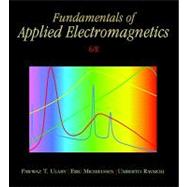For one- or two-semester courses in Electromagnetics.Widely acclaimed both in the U.S. and abroad, this authoritative text bridges the gap between circuits and new electromagnetics material.
Ulaby begins coverage with transmission lines, leading students from familiar concepts into more advanced topics and applications. Maintaining its student-friendly approach, this revision introduces full color and incorporates feedback from instructors and students.
KEY BENEFIT: Widely acclaimed both in the U.S. and abroad, this reader-friendly yet authoritative volume bridges the gap between circuits and new electromagnetics material. Ulaby begins coverage with transmission lines, leading readers from familiar concepts into more advanced topics and applications.
KEY TOPICS: Introduction: Waves and Phasors; Transmission Lines; Vector Analysis; Electrostatics; Magnetostatics; Maxwell's Equations for Time-Varying Fields; Plane-Wave Propagation; Reflection, Transmission, and Waveguides; Radiation and Antennas; Satellite Communication Systems and Radar Sensors.
MARKET: A useful reference for engineers.








